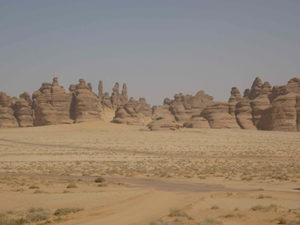MADA’IN SALEH BY VIRGINIA FORBES
The C130 lumbered into the dawn sky above Jeddah, heading northwards to Mada’in Saleh. I had waited 20 years for this visit, my every request being met with an ‘Inshallah’, and suddenly it was happening. A Nabatean city like Petra, Meda’in Saleh stands in the desert as Petra used to – unknown by the masses and visited by the very few.

Charles Doughty wrote of his ‘discovery’ in 1876, but a Greek writer, Diodorus Siculus, had written of the place as al Hijra , and now UNESCO has made it a World Heritage Site.
We watched the arid mountains and desert unfold beneath us, unable to talk above the roar of the plane’s prop-driven engines. From the cockpit the Captain pointed out Medina to our left, explaining that as I was an infidel, he couldn’t fly over the holy city. A short while later we saw the palm trees of al Ula, as we circled slowly over a brand new landing strip standing alone amongst the skeletons of new airport buildings. A phalanx of black cars, blue lights flashing, was lined up to greet our royal companion. The somewhat rotund soldiers stood to attention, the Special Forces distinguished by their red berets and considerably fitter physique. After greetings, our cavalade swept off along the road from al Ula, over a sandy gravel plain surrounded by harsh mountains, already fading into the morning heat. The road had been cleared of lesser mortals, and we raced through the al Hamdha and al Mazaz valleys empty of any traffic, seeing only camels and the odd flock of goats.

Suddenly we saw Mada’in Salah. Massive outcrops of yellow sandstone rock seemed to bubble out of the plain to great heights, the sun burning them orange and red. Unlike Petra, the site is not entered through a siq, but extends over a vast area, comprising 94 monumental tombs, dating between 1 BC and 75 AD. Similar to the tombs at Petra, they are carved out of the sandstone with geometric designs and crenellations, topped by sculptures of eagles, vases and serpents. In contrast, the inside of the tombs are bare and undecorated. All around ,the natural erosion of the sandstone has formed dramatic curves and honeycombed perforations which appear almost man-made. The siq at Jabal Ithlib, surrounded by rocky summits, hides a deep gorge. Here a central gully cut by rain water has over the centuries carved a dramatic entrance, by which towers the vast diwan. The water captured here was used for purification in the worship of the principal Nabatean god, Dushara, and contained in the rock cistern inside the siq.
There was a wonderful feeling of exploration of the unknown, as no tourist disturbed the peace, and no litter disturbed the beauty. Discounting our armed escort, who after all belonged in this country, there were only three of us infidels, and that was a glorious feeling in this century of mass tourism. The airport will be built, Western tourists will come, and I will keep my memories of that almost solitary day.
In Allah ma a’sabareen!

